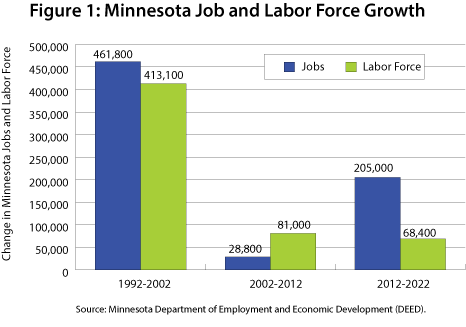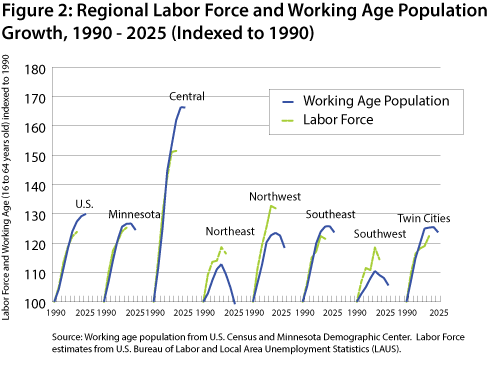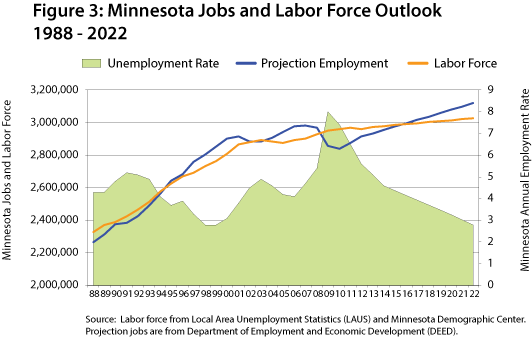
By Dave Senf
December 2014
Job growth in Minnesota is anticipated to slow in the near future as more baby boomers retire and the labor market tightens.
After enjoying a strong decade between 1992 and 2002, Minnesota job growth during the next decade was dismal, with the state and the country struggling to recover from the Great Recession.
Only 28,800 jobs were added in Minnesota between 2002 and 2012, a 1 percent increase.1 Labor force growth was a bit better, expanding 81,000 (2.8 percent), which was still far below the 413,000 labor force increase during the previous decade.
Job growth in the next 10 years is expected to be substantially improved over the 2002 to 2012 period, but it will be constrained by a shortage of workers. Minnesota is expected to add 205,000 jobs between 2012 and 2022, a 7 percent increase, but the labor force is projected to increase by only 68,400, a 2.3 percent increase (see Figure 1).2

The state's unemployment rate will dip below 3 percent later in the decade as job growth outpaces labor force growth in Minnesota. Within a few years, the state's unemployment rate will look a lot like North Dakota's rate in recent years and Minnesota's rate during the boom years from 1998 to 2000.
Minnesota's job growth did slow slightly during the last few years of the 1990s when a labor shortage developed, but the 2001 recession increased layoffs and decreased hiring, taking care of the labor shortage problem.
Waning labor force growth over the next decade will generate another tight labor market, barring another recession. Job growth will be significantly slower than 20 years ago. Unlike two decades ago, when the labor force was growing about 1.5 percent a year, annual labor force growth in coming years will be only about 0.3 percent, thereby intensifying the shortage of workers.
The retirement of the baby boomers, which started in 2008 when the oldest baby boomers turned 62, isn't the only factor behind waning labor force growth, but it is the major factor.
Baby boomers, those born between 1946 and 1964, first entered the labor force in 1962 and continued to pour into the labor force through the 1970s and '80s, with the youngest baby boomers turning 16 in 1980. Female participation rates in the labor force were also climbing, adding an additional boost to labor force growth. The boomer share of Minnesota's labor force peaked in 1989 at 57 percent. That was right on schedule, as the peak year for baby boomer births was in 1957.
The 1957 boomers turned 32 in 1989, putting them in their peak working years. They'll turn 62 in 2019 and 65 in 2022. According to the American Community Survey (ACS), the 2011 labor force participation rate was 88 percent for 30 to 34 year olds, 55 percent for 62 to 64 year olds, and 32 percent for 65 to 69 year olds. That means that 88 percent of the 1957 baby boomers were in the labor force in 1989, while only 55 percent will be in the labor force in 2019 and only 32 percent in 2022.
The baby boomer share of Minnesota's labor force has dropped from the peak of 57 percent in 1980 to roughly 30 percent today. By 2025 only 10 percent of the state's labor force will be baby boomers.
Demographics is destiny when it comes to Minnesota's labor force growth, holding all other factors constant. The slow labor force growth scenario might prove to be overly pessimistic if some other factors break the right way. Labor force participation rates have been dropping in Minnesota since 2001 and nationally since 2000. That trend will continue as the baby boomers retire, but the decline may be less than expected as labor markets tighten across the country. Labor force participation always drops during recessions, but the decline during the Great Recession was much larger than past recessions.
Labor force participation also might be boosted by baby boomers continuing to work longer than past generations. Labor force participation trends by older workers in Minnesota in recent years have been mixed, with participation rates increasing for 55 to 64 year olds but declining for 65 and older.
Immigration might also surprise on the upside, with more workers moving to Minnesota than expected. This occurred during the 1990s boom years, but since labor markets will be tight across the nation in future years there may be no repeat of the uptick of interstate immigration.3.
Minnesota's labor force, unlike most other states and the country as a whole, continued to grow during the Great Recession, increasing 1.4 percent between 2008 and 2011. The U.S. labor force declined 0.4 percent during that period. Minnesota's labor force growth has slowed over the last few years, while the U.S. labor force has rebounded since 2011, regaining its peak pre-recession level by 2013.
The rebound hasn't been even across states. Minnesota is one of only 18 states that recorded their largest annual labor force in 2013. Michigan's labor force peaked in 2000, West Virginia in 2006, and Rhode Island and Ohio in 2007. Of our neighbors, South Dakota and North Dakota recorded their largest annual labor forces in 2013, but Iowa's peak was in 2008 and Wisconsin's was in 2009.
The variation in labor force growth across Minnesota looks much like the variation nationally. Only in the central and metro regions of the state is the labor force larger today than before the recession. In all the other regions, labor force numbers in 2014 were smaller than in 2010.4. During the 2010 to 2014 period, the labor force of the northeast, northwest, southeast and southwest regions decreased by a total of 15,000 workers, while it increased by 46,300 workers in the central and metro regions.
Almost all of the state's labor force growth over the last four years (98 percent) has been in the metro region, with the central region gaining just a few hundred workers. The metro's labor force increased 2.9 percent over the last four years, while Greater Minnesota's labor force shrank 1 percent.
Stagnant or shrinking labor forces in Greater Minnesota can be partially attributed to a weaker economic rebound than in the metro region since the recession ended. The job market has been weak in Greater Minnesota, and fewer people have been enticed to return to the labor force. Equally important, however, is the older labor force in Greater Minnesota. Retirement levels are probably higher in Greater Minnesota due to the older workforce.
The drop in labor force in Greater Minnesota is shown by region in Figure 2 along with the actual and projected working age population through 2025. Labor force totals are presented for 1990 to 2010 in five-year intervals and for 2014. Working age populations are presented for 1990 to 2025 in five-year intervals.

Minnesota's working age population is projected to peak out for a decade or so in 2020, as is the working age population in the central, southeast and metro regions. Working age population will peak around 2015 in the northwest and southwest regions. The northeast region is already experiencing a declining working age population.
Working age population projections are a pretty good proxy for future labor force unless immigration is higher than expected or labor force participation rates increase. Job growth will be constrained by slower labor force growth, although an increase in people holding multiple jobs or more commuting by workers outside the regional or state borders might allow job growth to exceed labor force growth for a while. Falling unemployment will also support job growth for a few years, but eventually the unemployment rate will go as low as it can.
Minnesota will be facing slowing job growth in a few years, given the anticipated tailing off of labor force growth that really kicks in later this decade. As the state's job market tightens, only some of the hole left by the steady stream of baby boom retirements can be filled by drawing marginally attached workers back into the labor force. Minnesota's labor market is headed back to unemployment rates below 3 percent as shown in Figure 3. The exit of baby boomers from the labor force, which has been written about and discussed for the last two decades, is here.

1Jobs as used here refers to a count of jobs in Minnesota used for long-term projections. It's a hybrid estimate of Minnesota jobs based primarily on Quarterly Census of Employment and Wages data (QCEW) supplemented by estimated self-employed jobs from the American Community Survey and some jobs that aren't covered in QCEW employment but are accounted for in Current Employment Statistics (CES) job estimates. Projected job numbers track closely historically with the Local Area Unemployment Statistics employment estimate. Minnesota 2012- 2022 projections.
2Labor force projections come from the Minnesota State Demographic Center, Minnesota Labor Force Projections - Rates and Totals, 2010-2045, September 2014.
3See "In the shadow of the Boomers: Minnesota labor force outlook," Minnesota State Demographic Center, December 2013, for a more in-depth analysis.
4Annual regional labor force estimates for 2014 are based on the average of regional seasonally adjusted labor force estimates from January to September 2014.